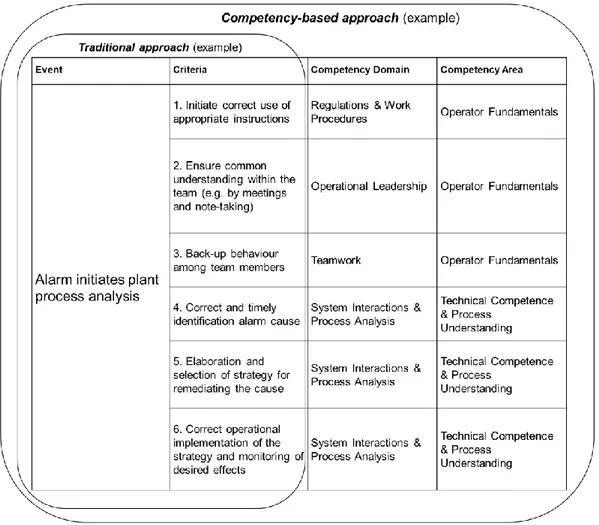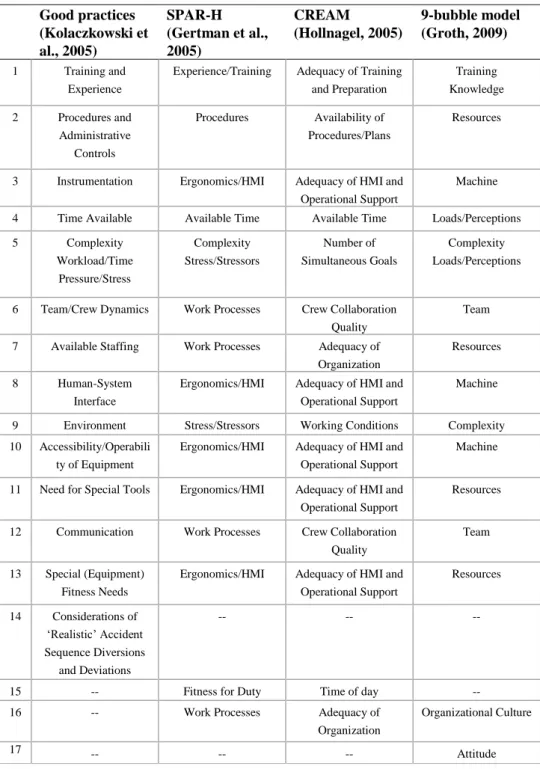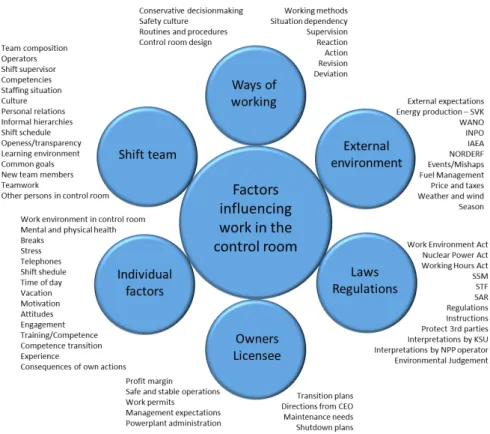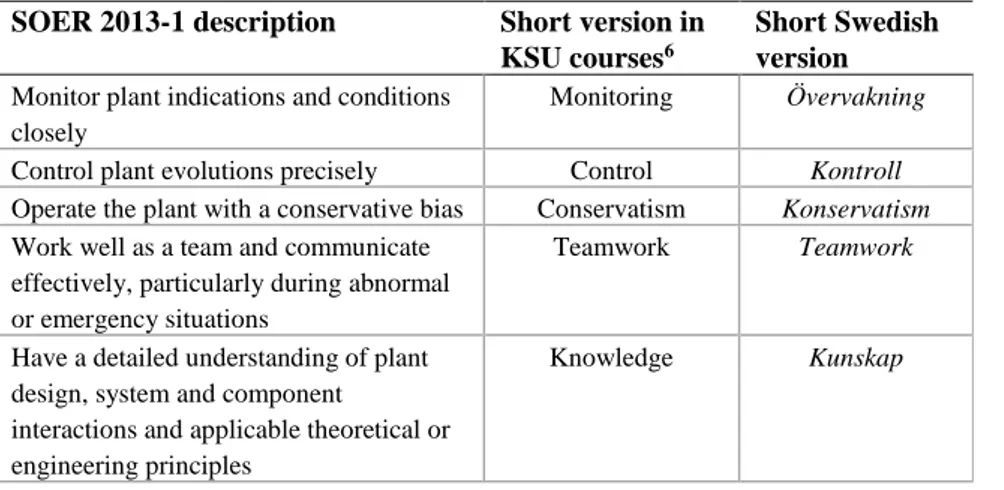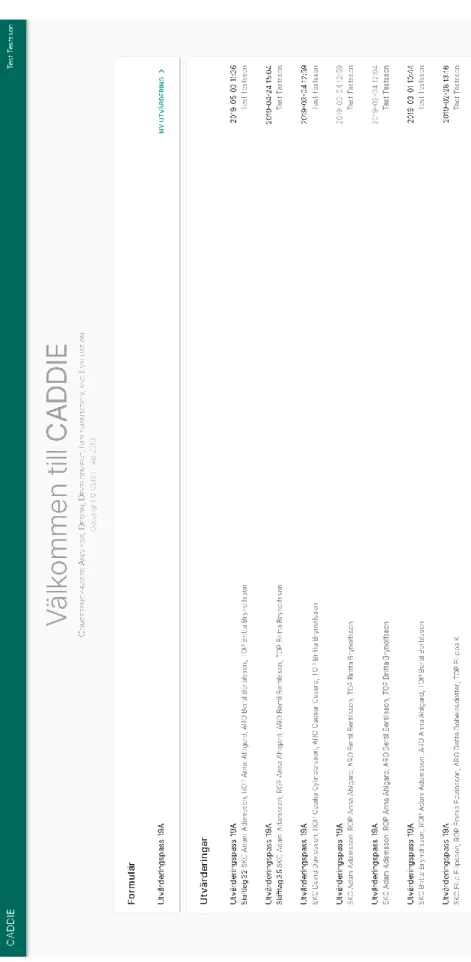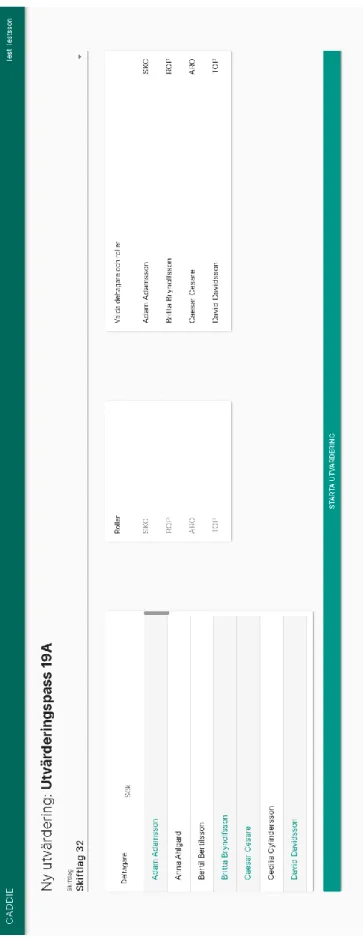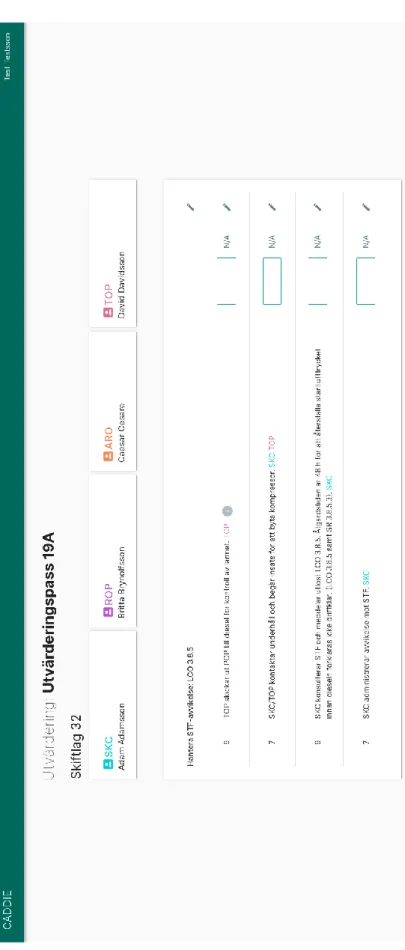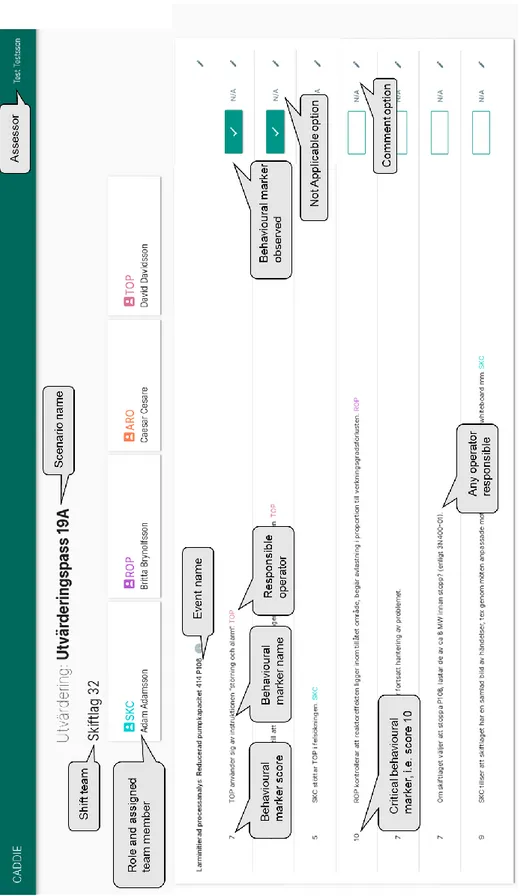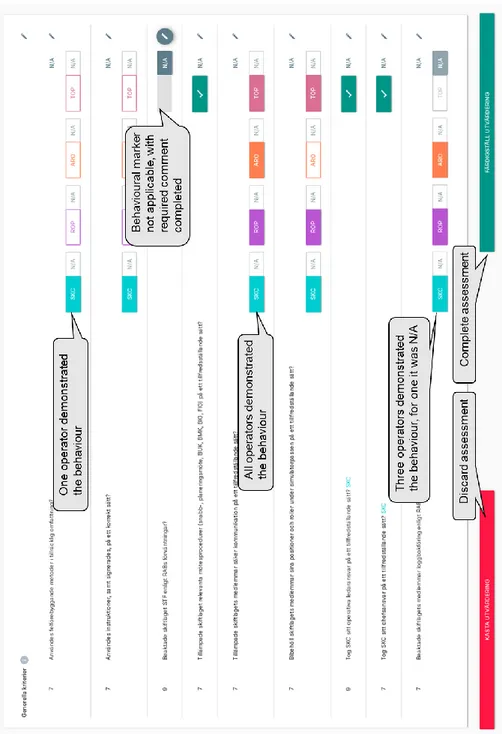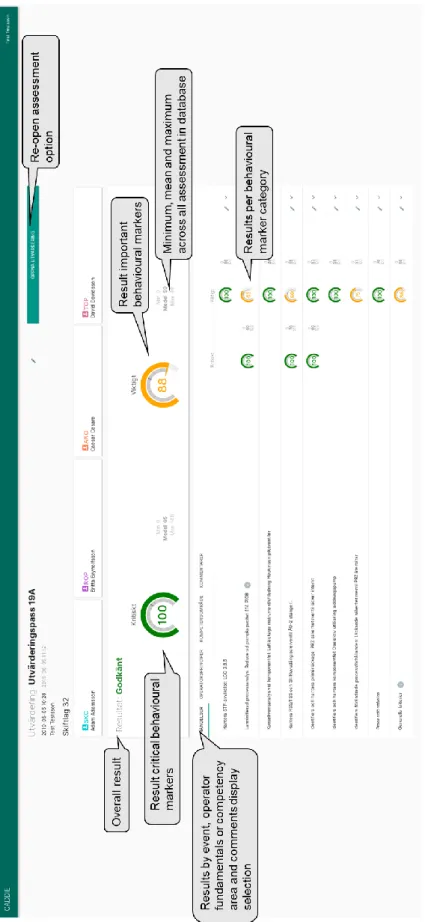Competency-based
assessments of
Nuclear Power
Plant control room
operators
- Experiences of development and first opera tional
methodological and technical demonstra tor application
Research
2020:11
Authors: Jonathan Borgvall, Martin lnsulander, Martin Castor, Erik Markström,
Geistt, Stockholm Report number: 2020:11 ISSN: 2000-0456 Available at: www.ssm.se
SSM 2020:11
The ability of the control room operators is paramount to secure safe
and stable operations of nuclear power plants. Due to changes in the
industry, new operators might not stay as long in each position, nor
experience the same amount of operating incidents, as operators did
twenty years ago. The last ten years concerns on operators’ future
abil-ity to meet challenges have been raised, e.g., the operators’ integrated
system knowledge, the technical basis for procedures, the reasons for
operational practices and power plant fundamentals.
Integrated System Validation (ISV), based on NUREG 0711, is often used
to ascertain that a proposed design meets applicable demands, and to
optimize usability. In ISV a proposed design is often evaluated against
knowledge of general ergonomic principles but also against the specific
prerequisites of the proposed users, in this case the operators.
The Swedish Radiation Safety Authority commissioned this study to
inform itself on the applicability and value of utilizing a
competency-based assessment approach in the ISV-process, and when training main
control room operators in full-scale simulators.
Traditional methods for assessing an operator’s ability typically focus on
a collection of specific components of competence, or on specific tasks.
A competency-based method could complement traditional methods by
mapping competence components to clusters, or competence domains,
resulting in a more purposeful training, and in the operators’ ability
being more resilient.
Results
Thirteen shift teams performed tasks in a simulator, and were assessed
with the tool CADDIE. The tool was adapted to the situation based on
thorough task analyses through SAT-methodology complemented with
WANO’s Operator Fundamentals. Instructors and operators thought that
the tool was valuable and efficient in supporting their ordinary process
and has relevance to ISV processes and training processes.
Even though no empirical conclusions concerning ISV applicability
could be drawn, due to lack of appropriate projects during the study, the
authors believe the results to have clear relevance for ISV as well as the
design and assessment of training programs.
Relevance
This study aimed at testing the applicability and value of a
competency-based tool for assessing the performance of control room operators
during training in full-scale simulators. The results imply the method
and tool to be a useful complement in assessing operator performance,
both in ISV for proposed design and in the training of control room
operators. In utilizing the method studied, and in providing more
knowl-edge on how to train operators to give them a more resilient ability to
operate the plant safely.
Background
SSM 2020:11
The study relates to the continued development of regulations and
guidelines concerning the competencies of the control room operators.
With a solid SAT analysis as a foundation, the competency-based
assess-ment approach opens possibilities for new ways to identify and express
assessment criteria as it provides a complementary framework upon
earlier assessment options.
In the specific aspect of assessing and evaluating the operators’
abil-ity and level of competence, the CADDIE-tool can be seen as a valuable
complement to traditional methods. In part based on that it may be
adapted to specific needs, and in part of it is reported to be efficient
and easy to use, and perhaps most important because it captures more
nuances in the responses from the operators than traditional methods do.
SSM welcomes the development in the ISV area and believe it can
con-tribute to the further development and strengthening of the traditional
validation methodology. The study also illustrates the value of
conduct-ing research and co-operation between various stakeholders and as
part of working with continuous improvements within the framework of
safety.
Need for further research
A suggestion for continued research linked to this theme would be
studies where the methodology is used in appropriate projects as part
of the ISV process. Such research could lead to ecologically more valid
scenarios.
Another suggestion for continuing research linked to this theme is
further tests of the CADDIE tool as a complementary method in the
training of control room operators in full scope simulators and in
work-place coaching (APC). The purpose of such studies could be to analyse
whether there are differences in how the CADDIE tool works in practice
and in a broader context, i.e., a form of validation. A positive result may
lead to studies of possible specific contextual conditions that could
facilitate a more regular use of the methodology. Also, a study of the
effect of applying this complementary method in the training of control
room operators in full scope simulators and workplace coaching (APC),
could be interesting.
Project information
Contact person SSM: Johan Enkvist
Reference: SSM2018 1004 / 7030217-00
2020:11
Authors:
Date: July 2020
Report number: 2020:11 ISSN: 2000-0456 Available at www.stralsakerhetsmyndigheten.se
Jonathan Borgvall, Martin lnsulander, Martin Castor, Erik Markström
Geistt, Stockholm
Competency-based assessments of
Nuclear Power Plant control room
operators
– Experiences of development and first
operational methodological and technical
demonstrator application
SSM 2020:11
This report concerns a study which has been conducted for the
Swedish Radiation Safety Authority, SSM. The conclusions and
view-points presented in the report are those of the author/authors and
do not necessarily coincide with those of the SSM.
Competency-based assessments of Nuclear
Power Plant control room operators
– Experiences of development and first
opera-tional methodological and technical
demonstra-tor application
Authors: Jonathan Borgvall, Martin
Content
1. Introduction ... 7
1.1. Background ... 7
1.2. Rationale for the project ... 7
1.3. Caveats and delimitations ... 8
1.4. Structure of the report ... 9
2. Competency-based assessment ... 10
2.1. What is competency-based assessment ... 10
2.2. Use cases ... 13
2.2.1. Integrated System Validation, ISV ... 13
2.2.2. Training design and assessment ... 15
2.3. Factors affecting control room work ... 15
2.4. Operator fundamentals ... 16 3. Demonstrator development ... 17 3.1. Content development ... 17 3.2. Technical development ... 19 4. Data collection ... 28 5. Results ... 30 5.1. Operational experiences ... 30 5.2. Development experiences ... 31
5.3. KSU and RAB reflections ... 32
5.4. Discussion and concluding remarks ... 33
Author Note
The work described in the report was conducted by Jonathan Borgvall, Martin Insulander, Martin Castor, and Erik Markström of GEISTT AB (Group for Effectiveness, Interaction, Simulation Technology, and Training), Stockholm, Sweden. The authors express their gratitude to Kenth Standert and Bjarne Widheden at KSU (Kärnkraftsäkerhet och utbildning AB), and Magnus Linder together with involved operational staff at Ringhals NPP, for their support to this research effort. The work was funded by the Swedish Radiation Safety Authority (SSM) and commissioned by SSM to GEISTT AB as a research project with Yvonne Johansson as responsible research officer at SSM.
Correspondence concerning this report should be sent to Jonathan Borgvall, GEISTT AB, Isafjordsgatan 39B, 164 40 Kista, Stockholm, Sweden. E-mail: jonathan. borgvall@geistt.com.
Figures
Figure 1. Example to illustrate the difference between a traditional,
event-oriented approach compared to a competency-based approach ... 13
Figure 2. Widheden’s (2016) identification of factors affecting work in a nuclear power plant control room. ... 15
Figure 3. CADDIE intro screen. ... 20
Figure 4. Shift team members selection and role allocation screen.. ... 21
Figure 5. Example of the first event with behavioural markers. ... 22
Figure 6. Assessment screenshot with explanations. ... 23
Figure 7. Teamwork and general criteria. ... 24
Figure 8. Results view per event. ... 25
Figure 9. Results view per operator fundamentals. ... 26
Figure 10. Results view per competency area. ... 27
Tables
Table 1. Crosswalk of important factors in four HRA methods. ... 14Table 2. SOER 2013-1 Operator fundamentals. ... 16
Executive Summary
Competency-based assessments of nuclear power plant control room operators’ performance are useful for several Human and Organizational Factors (HOF) purposes, such as Integrated System Validation (ISV) as well as the design and assessment of training programs.
The current project was commissioned to GEISTT AB by the Swedish Radiation Safety Authority (SSM, Sw. Strålsäkerhetsmyndigheten) to inform SSM on the applicability and value of utilizing a competency-based assessment approach when main control room operators are trained in the full-scale simulators of nuclear power plants. The project was initiated in February 2018 and concluded in June 2019. During the project, GEISTT, supported by domain expertise at KSU Ringhals (Sw. Kärnkraftsäkerhet och Utbildning AB) and Ringhals Nuclear Power Plant (RAB) operated by Vattenfall AB, modified a competency-based assessment tool, CADDIE, to fit the specific requirements of KSU and RAB. Domain relevant competency content was developed, based on SAT-based evaluation criteria, integrated into CADDIE, and tested during operational assessments sessions in the full-scale control room simulator.
Tests, with data being collected, were conducted during the spring of 2019. Thirteen shift teams of control room operators at the nuclear power reactors of Ringhals 3 and Ringhals 4 participated. The competency-based assessment enabled through CADDIE methodology and digital tool, was used during the evaluation sessions of the annual refreshment training weeks.
The competency-based assessment approach tested was considered valuable and effective by the staff of KSU and RAB. The tool supported their assessments in terms of quality, reliability, and ease of use. Consequently, KSU and RAB are jointly evaluating the potential implementation of a competency-based method and tool framework, building on their existing SAT-based evaluation criteria.
Sammanfattning
Kompetensbaserade utvärderingar av förmågan hos operatörerna i det centrala kontrollrummet i kärnkraftverk är användbara för flera Människa-Teknik-Organisation (MTO) relaterade syften, exempelvis Integrerad System Validering (ISV) och utformning och utvärdering av träningsprogram.
Det aktuella projektet finansierades av Strålsäkerhetsmyndigheten (SSM) med GEISTT AB som leverantör, i syfte att upplysa SSM vad gäller tillämpligheten och värdet av att använda en kompetensbaserad ansats när operatörer i det centrala kontrollrummet utvärderas i full-skalesimulator. Projektet påbörjades i februari 2018 och avslutades i juni 2019.
Under projektet modifierade GEISTT, understödda av domänexpertis från KSU (Kärnkraftsäkerhet och Utbildning AB) och Ringhals kärnkraftverk (RAB), sitt kompetensbaserade utvärderingsverktyg/-metod, CADDIE, för att passa de specifika kraven från KSU och RAB. Relevant kompetensbaserat innehåll utvecklades, baserat på utvärderingskriterier från den existerande SAT-analysen. Dessa kriterier grupperades utifrån CADDIE metoden och integrerades i det digitala verktyget som sedan användes under utvärderingarna.
Tester där data samlades in genomfördes under våren 2019. Tretton skiftlag med operatörer från reaktorerna Ringhals 3 och Ringhals 4 deltog.
Detta test av kompetensbaserad utvärdering upplevdes värdefullt av personalen vid KSU och RAB. Metoden och verktyget ansågs vara ett effektivt stöd för utvärderingarna i termer av kvalitet, reliabilitet, och enkelhet vad gäller användandet. Som en konsekvens utvärderar nu KSU och RAB gemensamt en potentiell operativ implementering av metod och digitalt verktyg för kompetensbaserad utvärdering, med utgångspunkt i de befintliga SAT-baserade kriterierna.
1. Introduction
1.1. Background
Competency-based assessments of control room operators’ performance are useful for several Human and Organizational Factors (HOF) purposes, such as Integrated System Validation (ISV) processes as well as the design and assessment of training programs. The current project was commissioned to GEISTT AB by the Swedish Radiation Safety Authority (SSM, Sw. Strålsäkerhetsmyndigheten) to increase SSM knowledge for future oversight of competence related aspects, by evaluating the applicability and value (incl. clarity of results) of utilizing a competency-based assessment approach when main control room operators are trained in the full-scale simulators of nuclear power plants. The project was initiated in February 2018 and concluded in May 2019.
1.2. Rationale for the project
The research efforts of the project relate to the continued development of regulations and guidelines concerning the competencies of the control room operators, c.f. SSM (2008) and SSM (2014). The primary purpose of the research efforts of the current project was to investigate the possibilities and benefits of competency-based assessments of main control room operators’ performance. The research questions of the project concern how operators’ competencies can be assessed in a fair and effective way, and if the proposed competency-based approach is applicable in the current training regime of Swedish nuclear power plants. Based on earlier experiences of different assessment methodologies used for training and ISV in the Swedish nuclear power plant domain, the authors of the report identified a possibility to complement the existing toolbox of assessment methodologies and tools.
The difference between a traditional event-based training approach and a
competency-based approach can at first glance appear subtle, but the fundamental difference between the two approaches, regarding the basis for design and assessment of training, entails major advantages for the competency-based
approach. For the event-based approach an exercise is designed and assessed around specific events, e.g. can the operators manage the event “Reduced pump capacity 414 P108”. For a competency-based approach the design and assessment of the exercise is based on whether the operators can demonstrate the underlying competencies the allow them to manage the different events. Through the rigorous work of defining a competency model, and the identified links between different parts of the competency model, assessment criteria and events, the competency model forms a powerful foundation for analysis, which is further described in Section 2.1 and exemplified in
Figure 1.
The skilled control room operators and their competencies is one of the most important safeguards for safe and efficient operation of nuclear power plants. The need for nuclear power plant licensees (e.g. Vattenfall), operator training providers (e.g. KSU), and regulatory agencies (e.g. SSM), to continuously monitor the competency of main control room operators is for example highlighted by IAEA (IAEA, 2016). Grahn (2013) describes his results from interviews with actors in the Swedish nuclear power plant industry and how the competence of the staff has a major effect on the safety and efficiency of a nuclear powerplant. Similarly, IAEA (IAEA,
2016) points out that a competency assurance process is an important requirement in order to secure safe and stable operations of nuclear power plants.
The need for competency assessment has always been present, but the importance is currently increasing, being emphasized by the changing demographics and changing employment situation/job market for nuclear power plant control room operators. For example, younger employees don’t necessarily stay as long on their positions as older generations. Therefore, competency gaps and training needs must to be monitored more closely than what has been done historically.
WANO1 has in the SOER2 2013-1 report on Operator Fundamentals Weaknesses (WANO, 2013) analysed a number of accidents and deviations that can be attributed to a decline in the so called Operator Fundamentals, see section 2.4 below for further description, and this merits closer attention to the development or decline of control room operators competencies. WANO is currently also increasing their attention to the follow-up of the Operator Fundamentals3 (e.g. WANO, 2018).
1.3. Caveats and delimitations
The purpose of the report is to demonstrate the usefulness and practical applicability of a competency-based assessment approach. Dummy data, in form and content identical to what that was collected during the project, will be presented in the report in order to exemplify the possibilities, but no analysis of the actual performance of the participating control room operators will be presented.
The competency-based approach that was used in the project has relevance both to ISV processes and training processes. Access to a current training related effort was made possible during the project and the conclusions in the report primarily relate to this training effort. No access to an ISV process with data collection possibilities relevant for the project, was available during the project’s lifetime. As will be exemplified below, there is clear relevance for ISV, but no empirical conclusions concerning ISV applicability could be made during the project.
1 World Association of Nuclear Operators 2 Significant Operating Experiences Report
3
1.4. Structure of the report
The report is intended to describe the activities conducted within the project and present the operational experiences of using a competency-based assessment tool. In the Competency-based assessment section, section 2, the foundations of competency-based assessment are described.
In the Demonstrator development section, section 3, the methodological and technical work regarding the specific assessment tool CADDIE, both in terms of content and technical features, is described. Several screenshots specific to the Ringhals version of CADDIE are provided.
In the Data collection section, section 4, the set-up of the data collection evaluation the methodology and the tool is described.
In the Results section, section 0, the experiences of using CADDIE in the Ringhals 3 and Ringhals 4 training simulator during refreshment training weeks are described. In the Conclusions section, section 5.4, the overall conclusions from the project are presented.
2. Competency-based assessment
The main control room operators and their performance represent some of the most important factors of nuclear power plant safety. The performance of these operators can be assessed in several different ways and for several different purposes. Examples where the current project has implications are Integrated System Validations (ISV), training design and training assessment.
2.1. What is competency-based assessment
Competency is a foundation for human performance that is used to reliably predict successful performance on the job. Competency is manifested and observed through behaviours which are based on the relevant knowledge, skills and attitudes to carry out activities or tasks, under specified conditions. Competencies allow people to formulate solutions for complex and difficult situations, including those situations that they are experiencing for the first time.
IAEA (1996) Technical Report 380 defines competence and competency:
Competence: The ability to put skills and knowledge into practice in order to perform a job in an effective and efficient manner to an established standard,
Competency: A group of related knowledge, skills and attitudes needed to perform a specific job.
IAEA’s (2006) definition combines competence and competency in the following way:
Competence (competency). (1) The ability to put skills, knowledge and attitudes into practice in order to perform activities or a job in an effective and efficient manner within an occupation or job position to identified standards. (2) A combination of knowledge, skills, and attitudes in a particular field of work, which, when acquired, allows a person to perform a job or task to identified standards. Competence (competency) may be developed through a combination of education, experience and training. A definition of competency in SSM documentation, proposed by Enkvist (2014), based on a synthesis of the Swedish Standard 624070 (2009)4 regarding “Quality Management – The process for competency management” and IAEA’s NS-G-2.8 (IAEA 2002) and IAEA Technical Report 380 (1996) competency is:
The ability and will to conduct a task by effectively applying knowledge and skills so that the desired result is achieved:
o ability = the experience, understanding, and judgement to apply knowledge and skills
o will = attitudes, engagement, courage, and responsibility
o knowledge = facts and methods, both formally and based on experience – “to know”
o skills = be able to execute in practice – “to do” (translated from Enkvist, 2014)
The foundation of a competency-based assessment approach is a competency model. Competency models, on a certain level of abstraction, describe what people need to
know and be able to do in order to do their job. Competency models serve as tools to identify and help close training gaps. Thus, a competency model is a framework for defining the skill and knowledge requirements of a job. Through the description of a set of competencies, the requirements for a job role can be specified. Competency models are widely used in business analyses for defining and assessing competencies within organizations, both regarding “hard” and “soft” skills. One reason for the growing popularity of competency modelling is that competency models often quite clearly map to the goals and strategies of an organization.
Typical competency model components are skills, knowledge, and attitudes. Given the description of competency above, competency-based assessment refers to assessments that are based on the above described elements of skills, knowledges and attitudes and explicit linking between different parts of the model.
Organisational benefits enabled in organizations that implement a competency-based training programme typically include (e.g. Wilson, Bennett, Gibson, & Alliger, 2012):
Recurrent performance evaluation of operational personnel.Competency-based assessments enable identification and collection of assessment evidence which supports decision-makers/managers/regulatory agencies in monitoring the competence of the operational personnel.
Early identification of performance gaps and design of more effective training to close performance gaps.Accurate identification of performance gaps can be challenging in control room operator training, given the complex cognitive nature of their job. Using well defined performance criteria to identify how training gaps appear or disappear over time can ensure that the training is more targeted and effective for the operators.
Training to meet individual needs. Meeting the training needs of each control room operator means recognizing that a “one-size fits all” training approach won’t guarantee success. Being able to identify and address specific training gaps and specific individuals’ needs will ensure the development of the required competencies in each operator.
Development of recruitment and selection tools.With a clear definition of what competencies are required for a job, recruitment programs can be tailored to select those individuals who already possess aptitudes in relevant areas. Support during change management processes. Changes, both technical and procedural, in the nuclear power plant domain require deep understanding of very complex and extensive processes. Introduction of new equipment and new operational procedures thus requires continuous learning. Specific identification of competencies and associated performance criteria supports a more accurate analysis of how the operators’ tasks and ways of working will be affected by changes.
The main difference between competency-based assessment and more traditional methods is that the former does not only focus on specific assessment components (see Figure 1 for further explanation) such as skills, knowledge, attitudes, or events. Instead a competency framework is identified where such components are mapped to higher orders of competency clusters, often expressed as competency domains and/or competence areas. By doing this, the assessment of a specific component, e.g. a specific skill, propagates to a higher competency level, e.g. a competency domain, together with other competency components associated with that competency domain, regardless of what the specific events or actions was.
Traditional methods often focus solely on specific competency components, and most often these are linked to specific events. Although the assessment criteria are often thoroughly analysed and well-defined, they typically lack these linkages to higher order competencies. This means that a specific skill or knowledge demonstrated for a certain event, has no links to the same/very similar knowledge/skill demonstrations for another event. One consequence of this is that if two different events to 70% require the same demonstration of a skill/knowledge (i.e. 30% being different), the assessment result of these will not be automatically linked by contributing to the same higher-order competency. In essence, the development of a richer competency model where links and relations between different competency components, assessment criteria and events are made explicit is the main difference, and by many considered the main advantage, of a competency-based approach.
The difference between a traditional and a competency-based approach is further illustrated by the example in Figure 1 below.
Figure 1. Example to illustrate the difference between a traditional, event-oriented approach compared to a competency-based approach. The former focuses on each criterion as solitudes in relation to a specific event, whereas the latter has on overarching competency structure that allow aggregation, in this example from criteria to Competency Domain and then further to Competency Area. This allow training design, implementation, and evaluation to focus on competency clusters, and allows data collection and analysis (e.g. trending) across different events, rather than merely within.
2.2. Use cases
2.2.1. Integrated System Validation, ISV
NUREG-0711 (NRC, 2012) describes how an ISV should employ a hierarchical set of performance measures including measures of plant performance, personnel task performance, situation awareness, cognitive workload, and anthropometric/ physiological factors. A Human Reliability Analysis (HRA) can be conducted within an ISV process, and several HRA methods exist, see e.g. Bell and Holroyd (2009) for a concise review. In HRA’s, one recurring factor to analyse is the training and experience of the operators. This is exemplified by Boring’s (2010) crosswalk
between four different HRA methods, see Table 1. In the table, several factors that appear in the four HRA methods, i.e. at least factors 1, 2, 6, 12, 16 and 17 clearly map to assessment criteria used in the current project. Most of the other factors could also be addressed with the same tool and methodological approach with modified and/or added criteria, but were not assessed with the assessment criteria currently used during training at RAB.
Table 1. Crosswalk of important factors in four HRA methods by Boring (2010).
Good practices (Kolaczkowski et al., 2005) SPAR-H (Gertman et al., 2005) CREAM (Hollnagel, 2005) 9-bubble model (Groth, 2009) 1 Training and Experience
Experience/Training Adequacy of Training and Preparation Training Knowledge 2 Procedures and Administrative Controls Procedures Availability of Procedures/Plans Resources
3 Instrumentation Ergonomics/HMI Adequacy of HMI and Operational Support
Machine
4 Time Available Available Time Available Time Loads/Perceptions 5 Complexity Workload/Time Pressure/Stress Complexity Stress/Stressors Number of Simultaneous Goals Complexity Loads/Perceptions
6 Team/Crew Dynamics Work Processes Crew Collaboration Quality
Team
7 Available Staffing Work Processes Adequacy of Organization
Resources
8 Human-System Interface
Ergonomics/HMI Adequacy of HMI and Operational Support
Machine
9 Environment Stress/Stressors Working Conditions Complexity 10 Accessibility/Operabili
ty of Equipment
Ergonomics/HMI Adequacy of HMI and Operational Support
Machine
11 Need for Special Tools Ergonomics/HMI Adequacy of HMI and Operational Support
Resources
12 Communication Work Processes Crew Collaboration Quality
Team
13 Special (Equipment) Fitness Needs
Ergonomics/HMI Adequacy of HMI and Operational Support Resources 14 Considerations of ‘Realistic’ Accident Sequence Diversions and Deviations -- -- --
15 -- Fitness for Duty Time of day -- 16 -- Work Processes Adequacy of
Organization
Organizational Culture
2.2.2. Training design and assessment
Training programs can be designed in several ways, and the ways to assess training needs and training effects are many. However, a competency model, i.e. some form of description of what people need to know and be able to do in order to do their job, may be a very good starting point. It is also a requirement in order to do competency-based assessment of the type described in the report.
2.3. Factors affecting control room work
Widheden (2016), in Figure 2, exemplifies a variety of factors who affect the performance and work of operators in a nuclear power plant control room. The reason for inclusion of the figure is to demonstrate that even though competency is very important to assess, there are also a wide range of other factors that affect the work in the control room, of which not all are related to competency. Many of these factors are not addressed with the current competency-based assessment approach. Thus, it is important for the reader to understand that the proposed assessment methodology and tool represent a compliment to the existing assessment rather than being a replacement.
Figure 2. Widheden’s (2016) identification of factors affecting work in a nuclear power plant control room.
2.4. Operator fundamentals
In the SOER5 2013-1 document, WANO identifies five basic competencies called Operator Fundamentals. These five operator fundamentals are briefly described in Table 2 below.
Table 2. SOER 2013-1 Operator fundamentals.
SOER 2013-1 description Short version in KSU courses6
Short Swedish version
Monitor plant indications and conditions closely
Monitoring Övervakning
Control plant evolutions precisely Control Kontroll
Operate the plant with a conservative bias Conservatism Konservatism
Work well as a team and communicate effectively, particularly during abnormal or emergency situations
Teamwork Teamwork
Have a detailed understanding of plant design, system and component
interactions and applicable theoretical or engineering principles
Knowledge Kunskap
SOER 2013-1, through case examples, describes the risks with procedures that promote an over-reliance on checklists, i.e. that control room operators follow procedures exactly as written, but don’t necessarily have the in-depth knowledge of how the power plant respond in certain situations and conditions. In the SOER report there are also examples where checklists and procedures were not followed, and where the operator did not use the human performance monitoring/teamwork and deviation preventing methods (sw. felförebyggande metoder) that are part of standard operating procedures. Both these types of undesirable situations can be addressed if the competencies of the operators are assessed over time.
The rationale for the SOER 2013-1 report is that:
Operators are not sufficiently focused on understanding the technical aspects of the task to complement the use of human performance techniques.
An imbalance exists between ‘training on task’ implementation and training on integrated system knowledge, the technical basis for procedures, the reasons for operational practices and power plant fundamentals.
Risk recognition and mitigation are not used effectively to supplement the requirement to follow approved processes and procedures and ensure that activities are completed event-free.
Training techniques and needs have not been adjusted to account for operators having fewer opportunities to experience plant transients, safety system operation and other abnormal / unusual evolutions because plants in general are operating more reliably.
Consequently, WANO already has and increasingly will monitor the development over time for these operator fundamentals7 at their recurring inspections at nuclear power plants. This is one important rationale for the current project and the tool that was developed specifically enables assessment of operator fundamentals, which
5 Significant Operating Experiences Report
6 KSU course materials regarding the SOER 2013-1, (KSU, 2013)
7
previously not was easily assessable. With more data, from future assessments, changes in operator fundamentals, i.e. the trends regarding operator fundamentals, will become possible to assess in a manageable way.
3. Demonstrator development
In this section the development of the demonstrator for a competency-based assessment tool is described.
3.1. Content development
The authors of the report have a long research and development experience of activities that focus on competency modelling and competency-based assessments (e.g. Borgvall & Castor, 2006; Borgvall & Castor, 2010; Castor, Borgvall, & Bennett, 2009; Castor, Borgvall, Lagerbäck, & Lavén, 2008) in different domains, such as military aviation and civilian maritime operations. To further support this line of research and applied assessments, GEISTT has developed the CADDIE software tool and the associated methodological approach for competency-based content development.
Based on these earlier experiences, the primary design criteria for CADDIE has been:
The tool must be easy to use for the instructor/assessor that uses it.
The tool must be reconfigurable and easy to modify, as each specific implementation requires some customer specific adaptation, even though the basic tool needs are similar. For the competency model there will be differences between almost every application, i.e. regarding the assessment criteria and the visible content of CADDIE. For the assessment form design, there can also be some variation, e.g. regarding how many concurrent assessors that are active, and how results should be aggregated and presented.
The tool must support a very rapid feedback process. In a training situation it is rare to have time to export and analyse results before the debriefing session is conducted. Thus, the tool must include integrated analytical support.
For competency-based assessment to be useful and valuable, it requires a foundational competency model that is adequate for the purpose. It is during the definition of the competency model where the critical analysis and work is conducted. To be relevant in the current project, the CADDIE8 software tool obviously needs to be populated by human-system performance assessment criteria which are compliant with standard operating procedures at RAB. After initial contact with staff at KSU during the spring of 2018, the modification of CADDIE into a Ringhals 3 and Ringhals 4 specific implementation was conducted during the autumn and winter of 2018.
The assessment criteria used during the data collection were derived from the SAT analysis (Systematic Approach of Training, cf. IAEA, 1998), maintained by KSU and RAB. In the SAT analysis all work task that are conducted in the main control room are described in detail. The assessment criteria used in the current project are the same criteria that already were being used during the assessment sessions, but with a new
8 CADDIE is a software tool solely developed by personnel employed by GEISTT AB, Sweden, and is as such
structure and categorizations added, including the crucial links between the observable behavioural markers and competency model elements, i.e. the competency domains and competency areas of Figure 1. The essential mapping between assessment criteria and the operator fundamentals was developed during the project, in order to enable different result presentations of the shift teams’ performance. During ten workshops the assessment criteria from the SAT analysis were analysed, sorted and categorized in order to fit CADDIE’s competency-based assessment approach. To a minor extent the assessment criteria were modified, but only in form and wording in order to make them more succinct. The essence of the assessment criteria was still maintained from the SAT analysis.
For all the assessment criteria, with their respective behavioural markers in CADDIE, the responsibility of the assessor is to provide an Observed, Not Observed or Not Applicable decision and click (or not click) the corresponding button, e.g. click when the behaviour of a specific behavioural marker is observed. The assessor can also enter free-text comments if desired. This should be contrasted to many other assessment forms where the assessor’s responsibility is to provide a rating on a scale for the assessment criteria, for example select a rating between 1-6 for teamwork. In CADDIE the input is intentionally made simpler, i.e. the assessor answers the basic question “Did I see it, or did I not see it”, rather than making the more demanding 1-6 judgement. As a necessity, the weighting of the different criteria and decisions concerning importance and relations between criteria is therefore made beforehand, jointly by several assessors, and need to be very explicit. This increases the inter-rater reliability9, i.e. that assessors provide the same response when seeing similar operator performance in the control room. It also increases the transparency of how the assessments are conducted, for all participants and stakeholders.
9 The term typically used in scientific literature is inter-rater reliability, although here inter-assessor reliability
3.2. Technical development
The technical work of customising GEISTT’s existing CADDIE platform for the specific KSU and RAB requirements was straightforward as the data-label based architecture provided the required flexibility. Thus, the internal information model could be modified according to the specific details of the assessment scenarios. To present the visual design of the tool, and show what the assessors sees, the following screenshots follow an assessment from logging into CADDIE, up to the presentation of assessment results.
After logging in through a web browser, the assessor is met by an intro screen, see Figure 3, where new assessments can be created and earlier, completed assessments can be accessed. If a new assessment is created, the shift team members that will be assessed can be selected from the screen shown in Figure 4. Team members are selected from a list with all current control room operators and they are then assigned their roles in the coming assessment.
Figure 5 shows the first event in the scenario with corresponding behavioural markers. Figure 6 shows the same screenshot, but with explanations added for the reader of the report. During the Återträning 19A assessment 53 behavioural markers in nine clusters were used, with eight sorted by scenario events during the assessment, as this naturally follows the scenario timeline. Figure 7 shows the remaining teamwork related and more generic behavioural markers that are assessed at the end of the scenario. Figure 8 shows dummy results with results sorted per events in the scenario. Figure 9 shows a similar screenshot, but with results presented per operator fundamentals instead. Similarly, Figure 10 shows results per competency area, which maps to other assessment structures used by KSU and RAB.
4. Data collection
As mentioned before, competency-based assessments are useful for several purposes. For the current report, training assessment is in focus. However, these training sessions are comparable to ISV sessions in the sense that a scenario runs during which different events are introduced by training instructors. Hence in the regard of assessment of the operator’s competency of coping with different deviations, there are no major differences whether this is assessed during training sessions or during ISV sessions.
For the applied test of both the assessment tool (CADDIE, as described in section4) and the methodological competency-based approach of defining and implementing domain relevant content in the tool (see section 3.1), the refreshment training weeks during the spring of 2019 for Ringhals 3 and Ringhals 4 control room operators were deemed suitable.
In dialogue with KSU and RAB, the project was able to arrange for collaboration with KSU and RAB concerning the content development and the data collection during the seven refreshment training weeks in the spring of 2019. Hence, all experiences of the operational use of the tool presented in the report come from these refreshment training weeks, with the Swedish name “Återträning 19A”. These weeks were very appropriate for the project in terms of overall design of the weeks and they represented a real use case. The participation from all shift team of Ringhals 3 and Ringhals 4 main control room operators resulted in an adequate amount of test occasions and data being collected.
Over seven weeks, from week 10 to week 16 of 2019, the CADDIE tool, with domain relevant assessment content, i.e. assessment criteria designed to capture nuclear power plant operator’s performance in accordance with RAB Standard Operating Procedures, was used.
On the Monday of each refreshment training week, a diagnostic assessment session is conducted. CADDIE was used during these assessment sessions, with assessments provided by the responsible operations manager. Each week, one shift team from Ringhals 3 and one from Ringhals 4 participated. The tool was used for assessment thirteen times during these seven weeks.
An assessment session in the full-scale control room simulator during a refreshment training week is planned to run approximately 2,5 hours, with a continuous flow of injects and deviations of different types in the scenario. At least four operators; shift supervisor (SKC), reactor operator (ROP), assistant reactor operator (ARO), and turbine operator (TOP), were present and evaluated during each session. For some shift teams, additional members of the shift participated in supporting roles.
The events and deviations that the shift teams had to manage during the training sessions were designed to expose them to critical and realistic, although unlikely, events, imposing a realistic workload and exposing them to experiences undesirable during real operations.
The specific events and deviations that were used during “Återträning 19A” are described in Table 3.
Table 3. Events occurring during the “Återträning 19A” scenarios.
Event description Event description in Swedish
Deviation in Technical Specification LCO 3.8.5
STF-avvikelse LCO 3.8.5.
Reduced pump capacity 414 P108 Reducerad pumpkapacitet 414 P108 Air leak instrument air duct
for main steam isolation valve
Läckage instrumentluftledning till huvudångisolerventil
Inadvertent closure of main steam isolation valve
Huvudångisolerventil ÅG-2 stänger obefogat
Internal leakage PRZ safety valve PRZ säkerhetsventil läcker internt Unselective release of charging pump “Oselektiv” utlösning laddningspump PRZ safety valve leakage sealed Läckande säkerhetsventil PRZ återtätar
The events are concurrently managed by the operators during the sessions, with consequences of previous events possibly still being actively managed when new events are triggered by the simulator instructor.
5. Results
In this section the operational experiences from KSU and RAB of using the competency-based assessment approach are described. The specific results from the shift teams will not be presented or discussed as the purpose of the report is to describe how a competence-based assessment approach can be designed. The development experiences of GEISTT, both from a methodological and a technological perspective are also presented.
The assessors from RAB and staff at KSU made many detailed observations, documented by GEISTT, which can be used for any potential future development, but below the report summaries the more general experiences.
5.1. Operational experiences
The simplicity and straightforwardness concerning the user interaction of the tool was very appreciated.
Initially the operations managers, who were the assessors, continued with their usual procedure of making notes and observations on paper. However, they quickly changed their way of working to making all comments in the tool, as this notetaking really was supported by the tool. It was perceived as straightforward to keep track of what comments that relate to which event or criteria, much easier than compared to traditional pen & paper notes.
The comments functionality was primarily used for personal assessor notes and were then used as supporting material when the assessors provided feedback during the debrief.
The fact that the assessment criteria jointly had been reviewed among the assessors further increased the objectivity of the assessment and this was appreciated by the assessors.
The number of behavioural markers per event were higher for the first events, which resulted in more comments. The assessors voiced a general caution that the number of behavioural markers per event must be carefully analysed to that results not become skewed. For future use it is important that the assessors feel assured that the number of behavioural markers are based on a joint decision whether the behavioural markers employed really represent “a complete test” of the competency that is intended to be assessed.
Some uncertainties concerning how the collected data should be used after the assessment scenario was present, mainly due to the lack of procedures and experience of using the tool. Example questions related to when and how much of results that should be shown to the shift team during the debriefing, and how results should be used in the continuous learning process. For most of the thirteen training sessions, the results from the tool was not shown to the teams during the debriefing, but in the cases where results were shown it led to curiosity and positive reactions. It might be that the best practice is to show the results during the solo debrief with the shift supervisor and not with the whole shift team.
If the tool is to be used during all scenarios of the refreshment training weeks (i.e. not only the Monday assessment scenarios) and/or during APC (workplace coaching during real operations) the number of assessment
criteria and behavioural markers might need to be reduced, e.g. by using only the team related overall criteria.
It is very positive that the criteria are linked to the Operator Fundamentals, as this enables trending over time for the Operator Fundamentals, which should meet the WANO requirements for the Operator Fundamentals follow-up (c.f. recommendation #5 of SOER 2013-1).
With these experiences of using a competency-based assessment approach, new ways of designing scenarios and injects arise.
RAB document 1710550 (Ringhals, 2014) identifies several performance criteria that provide important information that should be considered for inclusions in future, continued development of CADDIE content.
5.2. Development experiences
Everything has worked well from a practical technical perspective, but the current tool and architecture does not include a server solution that enables distributed data collection. Thus, two separate computers with local storage of the data were used during the assessments. A future product must include a server-based solution and probably accommodate several simultaneous assessors.
The existing CADDIE common infrastructure and database design, where every datapoint is labelled with multiple labels, was efficient in the current project in the same way as is has been in previous projects with other customers. This enabled a straightforward transformation of earlier CADDIE software design to the KSU/RAB tailored version that was used in the current project.
The SAT analysis that KSU and RAB had conducted earlier was a very valuable and necessary precondition for the project. During the workshops that prepared the assessment criteria for the CADDIE based evaluations it became obvious that some modifications of the criteria was needed, not in essence, but in structure and clarity. Through the workshops the SAT requirements could be modified and categorised to fit the proposed competency-based approach. For the reader it is important to understand that the competency-based assessment approach is not in opposition to the SAT analysis. Rather it is a complement that adds new possibilities that are very useful, for example during training assessments were time and assessment effort need to fit within a quite tight schedule.
The needs and questions from other stakeholders should be analysed further. Now, the only stakeholder considered was the assessor, i.e. an operations manager evaluating his shift teams, during the debriefing situation. Other stakeholders might be inspectors from WANO, different management levels of the power plant, the operators participating in the training, or the training designers at KSU. If these other stakeholders’ questions are made more succinct the integrated analysis in the tool could be further developed.
The collaboration with the staff at KSU and RAB was very effective. After initial contact had been established through workshops were everyone was physically present, much of the analysis and content refinement could be
conducted though videoconferencing which led to reduced costs and a high work efficiency.
5.3. KSU and RAB reflections
The methodology and tool tests during this project support the identification of competency areas/domains in a wider perspective than before and allow identification of trends over time e.g. competency areas improving or degrading over a certain time range. The methodology will require definition of criteria in more detail, which will make them easier to observe in a precise and reliable fashion. The expectation is that the end result will be of higher quality, both for comparison and identification of trends. In the longer term the ambition is to identify more general competency areas/domains and focus education & training efforts on those, rather than on very specific events such as today. That said, and as proven during this research effort, the existing SAT-analyses provide a great base to build upon when defining competency areas and domains under which the criteria are grouped.
5.4. Discussion and concluding remarks
The competency-based assessment method & tool evaluated in this project displayed the following overall results in terms of operational use and utilization of results:
Results are collected in a digital format, rather than on paper. This enables a more rapid and automated compilation of results, which probably will increase the pedagogical value of the debriefing sessions and hopefully increases the shift teams’ capability to analyse the simulator sessions, which in turn should affect the learning quality of the training.
Provided that the importance of the different assessment criteria and their behavioural markers have been discussed jointly among the assessors the inter-rater reliability increases. A consensus has been achieved before the simulator sessions concerning what behavioural markers are critical and the respective importance of the other markers. Through this process the assessment of the training becomes more data driven and less susceptible to personal opinions, which could bias results. The assessments thus have a higher chance of being fair and more comparable between shift teams and assessors/operation managers.
Through the process described in the bullet above, the assessment criteria also become more explicit and transparent for the participating operators. The set of behaviours and expectations that they should live up to also becomes more robust over time, and not unnecessarily affected by issues that recently has got much attention.
The project has provided a boost regarding the assessment practices at KSU and RAB. With the solid SAT analysis as the foundation, the competency-based assessment approach has opened possibilities for new ways to express assessment criteria and it provides a complementary framework upon earlier assessment options. Through this new framework, application during training and workplace coaching (APC) becomes possible.
The lessons learned and areas for improvement that are identified during the debriefing sessions, including any actions for the shift team to develop after the training week become integrated in the tool, which facilitates follow-up over time. Any actions and plans for development also become linked to a competency level rather than only being linked to specific events, which opens new possibilities for remedial training or education.
All the benefits above were observed (or predicted when in operational use) with the approach and tool described in the report.
Things to develop further that has been discussed during the project are:
Stakeholder questions analysis. The data that are collected is relevant for
several different stakeholders, but these stakeholders have different types of questions. The control room operator that has just undergone refreshment training is interested in direct individual feedback on his/her areas of improvement. The operations manager is interested in the competency level of the team. The power plant operator might be interested in being able to prove to WANO that the operator fundamentals still are on a high level. The course designers at KSU might be interested in how competency develops
over time and detect any training gaps that might need to be addressed and how quickly these training gaps are managed.
Further detailed integrated analysis functionality. Pending the needs and
questions identified in the stakeholder questions analysis, the integrated analysis functionality could be developed further. More trending, statistical analyses and result visualisations could be developed to rapidly answer stakeholder questions. For the assessors the current design appears quite satisfactory, but increased experience of a competency-based assessment approach might affect and increase the desired functionality.
Full competency model. The full competency model for the control room
operators is more extensive that what can be captured during a single assessment session (or even training week). Thus, more content that described the full competency set needs to be defined.
Criteria definition. The evaluation criteria used during “Återträning 19A”
was based entirely on the criteria from the SAT analysis and worked well for the purpose of the current project. However, ultimately the injects and the whole design of the assessment sessions, and all the assessment criteria should be based on the set of competencies that are required from the start of the training design process. The requirements, from both a technical and methodological perspective, for use during training sessions and APC-sessions (Sw. arbetsplatscoaching) also should be analysed. Possibly the use during training session and APC-sessions could result in new tool requirements.
To summarize, the project has demonstrated successful, cost-effective transfer of the CADDIE method & tool (originally developed in the domains of military aviation and civilian maritime operations) following adaptions, primarily regarding a competency framework, to nuclear power plant operations for evaluation of operator-system performance in the main control room. The existing SAT-analyses provide a great springboard for taking the assessment criteria from an event-based approach to a competency-based approach. The project has sparked investigations at KSU and RAB, regarding the digitalization and implementation of a competency-based approach supported by digital tools.
6. References
Bell, J., & Holroyd, J. (2009). Review of human reliability assessment methods. HSE RR679. Buxton, Health and Safety Laboratory. Available at: http://www.hse.gov.uk/research/rrpdf/rr679.pdf
Borgvall, J., & Castor, M. (2006). Mission Essential Competencies: Kompetens - Operativa Krav. FOI-R--2106--SE. FOI Ledningssystem, Linköping. (in Swedish).
Borgvall, J., & Castor, M. (2010). Framing and Levelling Preparatory Training for Large Force Exercises. Proceedings of 8th annual Meeting of the Society for Human Performance in Extreme Environments, HPEE2010.
Boring, R. (2010). How Many Performance Shaping Factors are Necessary for Human Reliability Analysis. Proceedings of 10th International Conference on Probabilistic Safety Assessment and Management PSAM 2010. Available at: https://inldigitallibrary.inl.gov/sites/sti/sti/4814133.pdf
Castor, M., Borgvall J., & Bennett, W. (2009). Knowledge and skill-based evaluation of simulated and live training – from evaluation framework to field application. Proceedings of International Symposium of Aviation Psychology 2009. Wright State University: Dayton, Ohio.
Castor, M., Borgvall, J., Lagerbäck, N., & Lavén, P. (2008). Mätning av flygförarnas kunskaps- och färdighetsutveckling under Red Flag 2008 (Measurement of fighter pilots’ knowledge and skill development during Red Flag 2008). FOI-RH--0776--SE. FOI Informationssystem/FLSC, Stockholm. (in Swedish). Enkvist, J. (2014). Hur SSM kan reglera kompetens på olika detaljeringsnivåer (How
the Swedish Radiation Safety Authority can regulate competency at different levels of details). SSM Promemoria 14-2698. (in Swedish).
Gertman, D., Blackman, H., Marble, J., Byers, J., & Smith, C. (2005). The SPAR-H Human Reliability Analysis method. NUREG/CR-6883. Washington, DC: United States Nuclear Regulatory Commission. Available at:
https://www.nrc.gov/reading-rm/doc-collections/nuregs/contract/cr6883/cr6883.pdf
Grahn, N. (2013). Anpassning av utbildning till följd av anläggningsförändringar (Training modification due to power plant modernization). SSM Rapport 2013:25. (in Swedish). Available at:
https://www.stralsakerhetsmyndigheten.se/publikationer/rapporter/sakerhet-vid-karnkraftverken/2013/201325/
Groth, K.M. (2009). A Data-Informed Model of Performance Shaping Factors for use in Human Reliability Analysis. PhD thesis. College Park, MD: University of Maryland. Available at: https://drum.lib.umd.edu/handle/1903/9975
Wilson, M.A., Bennett, W., Gibson, S.G., & Alliger G.M. (Eds.) (2012). The handbook of work analysis in organizations: The methods, systems, applications, and science of work measurement in organizations. Routledge. Applied Psychology Series.
IAEA (1996). Nuclear Power Plant Personnel Training and its Evaluation - A Guidebook. IAEA Technical Reports Series 380, STI/DOC/010/380. Available at: https://www.iaea.org/publications/5714/nuclear-power-plant-personnel-training-and-its-evaluation
IAEA (1998). Experience in the use of systematic approach to training (SAT) for nuclear power plant personnel. IAEA-TECDOC-1057. Available at: https://www-pub.iaea.org/MTCD/Publications/PDF/te_1057_prn.pdf
IAEA (2002). Recruitment, Qualification and Training of Personnel for Nuclear Power Plants. IAEA Safety Standards Series No. NS-G-2.8. STI/PUB/1140. Available at:
IAEA (2006). Competency Assessments for Nuclear Industry Personnel. IAEA STI/PUB/1236. Available at:
http://www-pub.iaea.org/MTCD/Publications/PDF/Pub1236_web.pdf
IAEA (2016). Safety of Nuclear Power Plants: Commissioning and Operation. Specific Safety Requirements. IAEA Safety Standards Series No. SSR-2/2 (Rev. 1). Available at:
https://www-pub.iaea.org/MTCD/Publications/PDF/Pub1716web-18398071.pdf
Kolaczkowski, A., Forester, J., Lois, E., & Cooper, S. (2005). Good practices for implementing human reliability analysis. NUREG-1792. Washington, DC; US Nuclear Regulatory Commission. Available at:
https://www.nrc.gov/docs/ML0511/ML051160213.pdf
KSU (2013). Course materials regarding SOER 2013-1 Operator Fundamentals Weaknesses. (in Swedish).
NRC (2012). Human Factors Engineering Program Review Model. NUREG-0711, Rev. 3. Washington, DC: US Nuclear Regulatory Commission. Available at: http://www.nrc.gov/docs/ML1232/ML12324A013.pdf
SSM (2008). Strålsäkerhetsmyndighetens föreskrifter om kompetens hos driftspersonal vid reaktoranläggningar - Strålsäkerhetsmyndighetens allmänna råd om tillämpning av föreskrifterna om kompetens hos driftspersonal vid reaktoranläggningarna (The Swedish Radiation Safety Authority’s Regulations concerning the Competence of Operations Personnel at Reactor Facilities) SSMFS 2008:32. Strålsäkerhetsmyndighetens Författningssamling. ISSN 2000-0987. (in Swedish).
SSM (2014). Strålsäkerhetsmyndighetens föreskrifter och allmänna råd om säkerhet i kärntekniska anläggningar (The Swedish Radiation Safety Authority’s Regulations concerning Safety in Nuclear Facilities). SSM2008:1. Konsoliderad version med ändringar införda t.o.m. SSMFS 2014:3. Strålsäkerhetsmyndighetens Författningssamling. ISSN 2000-0987. (in Swedish).
Swedish Standards Institute (2009). Ledningssystem för kompetensförsörjning – Krav (Competence management systems – Requirements). Swedish Standard 624070:2009. (in Swedish).
Ringhals (2014). R1-R4 Kompetens- och behörighetsprövning av processoperatörer och kontrollrumspersonal version 19.0. (R1-R4 Competency and qualification examination of process operators and control room staff). Ringhals document ID: 1710550. (in Swedish).
WANO (2018). WANO Review. https://www.wano.info/getmedia/39dd170d-336c-4064-9cb1-51db01d3a82e/WANO-Review-2018-A4-Online.pdf.aspx
Widheden, B. (2016). Ett utbildningsperspektiv på utvärderingar av kontrollrum (An educational perspective on control room evaluations), Slides presented at SSM annual research seminar 2016. SSM2016-1614-1. (in Swedish).
The Swedish Radiation Safety Authority has a comprehensive responsibility to ensure that society is safe from the effects of radiation. The Authority works from the effects of radiation. The Authority works to achieve radiation safety in a number of areas: nuclear power, medical care as well as commercial products and services. The Authority also works to achieve protection from natural radiation an to increase the level of ratiation safety internationally.
The Swedish Radiation Safety Authority works proactively and presentively to protect people and the environment from the harmful effects of radiation, now and in the future.
The Authority issues regulations and supervises compliance, while also supporting research, providing training and information, and issuing advice. Often, activities involving radiation require licences issued by the Authority. The Swedish Radiation Safety Authority maintains emergency preparedness around the clock with the aim of limiting the aftermath of radiation accidents and the unintentional spreading of radioactive substances. The Authority participates in international
co-operation in order to promote radiation safety and finances projects aiming to raise the level of radiation safety in certain Eastern European countries.
The Authority reports to the Ministry of the Environment and has around 300 employees with competencies in the fields of engineering, natural and behavioral sciences, law, economics and communications. We have recieved quality, environmental and working environment certification.
Publikationer utgivna av Strålsäkerhetsmyndigheten kan laddas ned via stralsäkerhetsmyndigheten.se eller beställas genom att skicka e-post till registrator@ssm.se om du vill ha broschyren i alternativt format, som punktskrift eller daisy.
Strålsäkerhetsmyndigheten Swedish Radiation Safety Authority SE-171 16 Stockholm Phone: 08-799 40 00 Web: ssm.se E-mail: registrator@ssm.se ©Strålsäkerhetsmyndigheten E-pr int AB, 2020
